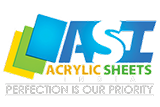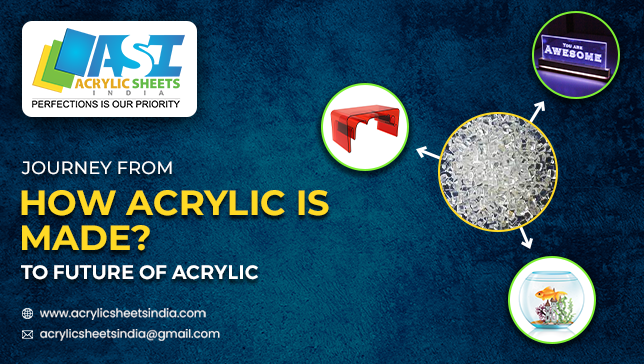Acrylic is polymethyl methacrylate or commonly known as PMMA which contains one or more derivatives of acrylic acid. Acrylic is a plastic that is an alternative to glass and has multiple uses and benefits being just identical to glass with additional features. It is also commonly known by other names like plexiglass, lucite, acrylic, perspex, acrylic, and crystallite in the industry. A big question that every acrylic user has in their mind is how acrylic is prepared with such exquisite properties. Let’s understand the process involved behind it.
The usual raw materials for the synthesis of PMMA are acetone, hydrogen cyanide, and sulphuric acid. The process of the synthesis of PMMA or acrylic is known as polymerization which uses multiple toxic substances as the raw materials but the end product is completely harmless and yet an extensive plastic and has a lot of advantages to the industry being an alternative option to glass.
Polymerization is the process of joining one or more substances together to form a new substance as a result of different properties. The production of PMMA starts with the reaction of methacrylic acid with methyl alcohol to form methyl methacrylate. The polymerization of this substance known as the monomer, methyl methacrylate produces polymethyl methacrylate (PMMA). PMMA is also broadly known as thermoplastics.
Properties of acrylic fiber
Acrylic has various properties involved with it and is very useful to the industry. Some of the general properties of the acrylic fiber are as follows-
- Outstanding stability toward different bleaching agents
- Good resistance to mineral acids. The resistance to weak alkalies is fairly good while hot strong alkalies attack acrylic
- Breaking elongation is 15% in both dry and wet states
- It has an elastic recovery of 85%
- Good thermal stability, the prolonged exposure above the temperature of 175*C can cause some discoloration
- Cost-effective
- Durable
- Can be molded into different shapes and sizes
- High optical clarity
- Light transmittance / diffusing
- Bullet resistant
- UV Filtering and transmittance
These properties of acrylic make it a suitable alternative for glass but have some dominating features to glass which in turn makes it a better material to be used.
Types of acrylic
There are two types of acrylic which are differentiated based on their synthesis procedure as well as the usage and properties to produce different end materials. They are cast acrylic which is a bit expensive as compared to the other that is extruded acrylic.
Cast Acrylic
It is prepared by injecting derivatives into molten form with a consistency of syrup. The cell cast or batch cell is made in sheets in a mold made of two polished glass plates with edges covered by gaskets. The liquid plastic fills the cavity between the mold made from two glass plates. Several plates have to be stacked to prepare different acrylic sheets. The molds are disassembled and cured
Extruded acrylic
Extruded acrylic is less costly as compared to the other type and this is the type of acrylic used in the industry majorly.
The manufacturing process
Acrylic plastic polymer is formed by the reaction of a monomer with the catalyst, generally an organic peroxide. The catalyst starts the reaction and enters to keep it going but doesn’t become part of the final product. Acrylic polymer is available in three different forms thin sheets, elongated shapes (rods and tubes), and molding powder. Molding powder is produced by the process of suspension polymerization and the acrylic plastic sheets are obtained by the batch cell and continuous bulk polymerization. Acrylic plastic sheets have many applications as an alternative to glass and normal plastic as acrylic is a thermoplastic.
Synthesis procedures
The most common synthesis procedures to produce acrylic are continuous bulk polymerization and batch cell bulk polymerization. The process of these synthesis procedures is discussed to give you a general idea about the synthesis of the most common thermoplastic with a wide variety of acrylic products.
-
Continuous Bulk polymerization
With the bulk polymerization process to obtain acrylic sheets, the polymerization of the monomer methyl methacrylate is done with a catalyst typically organic peroxides by pouring them into a mold, which is then sealed and heated to carry the reaction and produce the acrylic plastic polymer. From this polymer then the molded acrylic sheets are cured. It usually takes 10-12 hours to cure thin acrylic sheets whereas the thicker acrylic sheets take several days to be cured. The molds are then cooled and opened and as a result, the acrylic sheets are prepared which can be used immediately or processed further to enhance the overall quality of the sheets.
-
Batch cell bulk polymerization
Batch cell polymerization is another and the most widely used method to produce acrylic plastic sheets. The batch cell is the most commonly used form of bulk polymerization as it is effective in creating acrylic sheets of thickness from 0.6 inches to 6 inches and with a width from 3 feet to several hundred feet. This type of bulk polymerization produces acrylic of different measurements with a wide thickness range as well as a great width range.
Quality control
The storage, processing, and handling of all the chemicals used to synthesize acrylic are done under environmental conditions to prevent unsafe chemical reactions and the contamination of the material. Temperature control is very critical in the polymerization process. Before pouring the monomer and the catalyst into the mold, the temperatures are controlled.
From the initial to the end, the temperatures are monitored and maintained so that the heating and cooling cycles are happening at the correct temperature and right duration. The end products of the acrylic polymerization process are also monitored and analyzed at periodic laboratories for the confirmation of appropriate physical, chemical, and optical properties.
Uses
There are multiple uses and benefits of acrylic over plastic and glass-
- Transparent glass alternative
- Furniture
- Signage
- Accent walls
- Light covers
- Point-of-purchase displays
- Residential and commercial aquariums
- Interior layer of storm acrylic window linings
- Animal and reptile enclosures
- Police vehicles for riot control
- Medical technologies and implants
- Spectator protection for ice- hockey rinks
The uses of acrylic in the manufacturing industry are vast due to the advanced properties of its raw materials which makes it the material of choice for durability, strength, and optical clarity, and is quite flexible to get molded into different shapes and sizes. Some of the advantages of acrylic are its lightweight, blended appearance, strong, wrinkle resistance, warmth, and comfort making them suitable to make winter clothes like sweaters, shawls, and blankets. There are some disadvantages of acrylic as well such as low absorbency, heat- resistance, and weak and to overcome these disadvantages, acrylic is mixed with other materials to cover up.
Future of the acrylic
Acrylic is the future being a perfect alternative to plastics and glass offering a wide variety of advanced applications. The average annual increase in the rate of the production of acrylic has been up to 10%. In the coming future, an annual increase of 5% is predicted. Acrylic plastics are one of the oldest plastic materials and hold a lot of advantages as well like optical clarity, high strength, and thermal stability with light resistance to the outdoor environment to make them the appropriate material for many different applications.
Acrylic Sheets India ( ASI) provides one of the finest products when it comes to acrylic and has a wide range of acrylic sheets, boxes, display risers, acrylic photo frames, house nameplates, etc. We, at Acrylic Sheets India, have outlined ourselves as “Perfection is our priority” and the same is what we reflect with our products. We provide customized acrylic products and you can also get your hands on the trendy neon sign lights made of acrylic to light up your space and mood. The customized neon sign lights as per your requirement, the vibe is what we carefully take care of. Our products are perfect for events, weddings, homes, bars, cafes, and workplaces and make up a perfect gift for your loved ones on all occasions. So, if you are looking for an alternative to plastics or glass which is durable, high strength, and has a high optical clarity then acrylic products of Acrylic Sheet India are what you have been missing out on with the premium quality and best services in the market.

